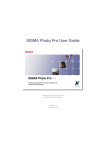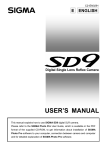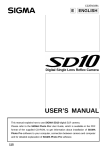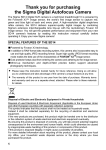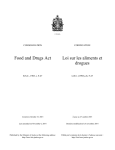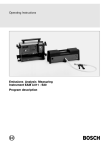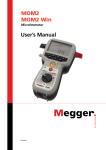Download Sigma PHOTO PRO 4.1 - FOR MACINTOSH User guide
Transcript
SIGMA Photo Pro User Guide Companion Processing Software for SIGMA Digital Cameras Version 2.5 For WINDOWS I M P O R T A N T : Please Read Before You Start Thank you very much for purchasing this SIGMA product. To receive maximum performance and enjoyment, and to not cause any injury or damage, please read this instruction manual carefully before using this product. Notices • Do not reproduce this manual in any form in whole or in part without prior permission. • The contents of this manual may be changed without notice. • Although we have made all possible efforts to produce a very accurate manual, if you find any mistakes, please contact our customer support. No liability can be accepted for any errors. • The specifications of this product are subject to change without notice. • SIGMA and its licensor do not accept any liability for any kind of results incurred as a result of software operation. In order to avoid causing any damage or injury, please read the following very carefully before using this product. Warning !! Disregarding this warning sign when using the product can result in serious injury or other dangerous results. Warning !! Do not play the included CD-ROM(s) in an Audio CD-ROM player. Listening to the included CD-ROM with headphones on a music CD player can cause hearing loss. Playing the included CD-ROM on a music CD player could damage the speakers. The images recorded with this camera are intended strictly for personal use and should never be used in a way that infringes upon or contravenes international or domestic copyright laws and regulations. In addition, although it is intended purely for personal use, some restrictions may be applied to the photographing of demonstrations, performances, shows, exhibitions, or commercial properties, etc. Copyright or other legal rights should not be contravened. Trademark Acknowledgements FOVEON X3, and the X3 Logo are registered trademarks of Foveon, Inc. Compact Flash is a trademark of SanDisk Corporation. IBM PC/AT series computer is a trademark or registered trademark of International Business Machines (IBM) Corporation in the USA. Microsoft and Windows are either registered trademarks or trademarks of Microsoft Corporation in the United States and/or other countries Macintosh and FireWire are registered trademarks or trademarks of Apple Computer Inc. in the United States and/or other countries. Adobe and Adobe Photoshop, are trademarks or registered trademarks of Adobe Systems Incorporated. Microdrive is a registered trademark of Hitachi Global Storage Technologies in the United States and/or other countries. All other company or product names used in this document are trademarks or registered trademarks of their respective holders. SIGMA Photo Pro User Guide i T A B L E O F C O N T E N T S IMPORTANT:Please Read Before You Start i TABLE OF CONTENTS ii 1 1 INTRODUCTION 1.1 About SIGMA Photo Pro ..................................................................................... 2 What you can do in SIGMA Photo Pro; A quick visual tour................................... 2 Main Window elements.......................................................................................... 3 Review Window elements ..................................................................................... 4 1.2 About this manual ............................................................................................... 5 Symbols and conventions...................................................................................... 5 Navigating the on-screen version of the manual ................................................... 5 2 COMPUTER SET-UP 6 2.1 Installing the software......................................................................................... 7 Windows system requirements.............................................................................. 7 Installing and uninstalling software........................................................................ 7 2.2 Setting up your monitor ...................................................................................... 8 Verifying monitor brightness, gamma, and color ................................................... 8 Using a pre-existing monitor profile ....................................................................... 8 Choosing the best monitor resolution for your screen size ................................... 8 3 TRANSFERRING IMAGES 3.1 4 9 Transferring images from the camera to your computer .............................. 10 Connecting the SD14 or DP1 to your computer. ................................................. 10 To transfer image files from the camera to your computer.................................. 10 Using a Card Reader to copy images to your computer ..................................... 10 MANAGING IMAGES 11 4.1 Main Window Overview..................................................................................... 12 Main functions...................................................................................................... 12 Changing the size of the Main Window ............................................................... 13 Changing the size of the Navigation and Thumbnail Panes................................ 13 4.2 Displaying images in the Main Window .......................................................... 13 View images stored on your computer ................................................................ 13 4.3 Different ways to view thumbnails................................................................... 14 Changing the size and style of thumbnails .......................................................... 14 Sorting and filtering thumbnails ........................................................................... 14 SIGMA Photo Pro User Guide ii T A B L E C O N T E N T S 4.4 Renaming images .............................................................................................. 15 Renaming images outside of SIGMA Photo Pro ................................................. 15 4.5 Selecting images ............................................................................................... 15 Selecting one image ............................................................................................ 15 Selecting multiple images .................................................................................... 15 4.6 Marking, Locking, & Rotating images in Main and Review Windows .......... 16 Rotating images................................................................................................... 16 Marking and unmarking images .......................................................................... 16 Locking and unlocking images ............................................................................ 16 4.7 Deleting images in the Main or Review Window ............................................ 16 Deleting images ................................................................................................... 16 5 6 O F REVIEWING IMAGES 17 5.1 The Review Window .......................................................................................... 18 Opening a Review Window ................................................................................. 18 Main functions...................................................................................................... 18 5.2 Navigating through a folder using the Review Window ................................ 19 Choosing which image is displayed in the Review Window ................................ 19 Using Navigation Buttons to select images ......................................................... 19 Selecting specific images from the Main Window ............................................... 19 5.3 Using the Magnification Loupe ........................................................................ 19 Turning the loupe on and off................................................................................ 19 Changing the magnification of the loupe ............................................................. 19 Activating the loupe ............................................................................................. 20 How to read the RGB values in the loupe ........................................................... 20 5.4 Viewing Images with Highlight and Shadow Warnings ................................. 20 Using masks to analyze highlights and shadows ................................................ 20 5.5 Using the Adjustment Mode Settings.............................................................. 21 X3F Mode: Reviewing images with default adjustments (to match in-camera preview) ............................................................................................................... 21 Auto Mode: Reviewing images with automatic adjustments (dependent on image content)................................................................................................................ 21 Custom Mode: Reviewing images with a specific setting applied ....................... 21 Saving Current Unsaved Settings ....................................................................... 21 5.6 Multiple Review Windows ................................................................................. 22 Opening Multiple Review Windows ..................................................................... 22 Using multiple Review Windows to compare images.......................................... 22 Using multiple Review Windows to compare modes........................................... 22 PROCESSING & SAVING SIGMA Photo Pro User Guide 23 iii T A B L E O F C O N T E N T S 6.1 Main Window Processing ................................................................................. 24 Processing groups of images simultaneously ..................................................... 24 6.2 Review Window Processing ............................................................................. 25 Processing individual images .............................................................................. 25 Choosing a destination ........................................................................................ 25 6.3 Processing options ........................................................................................... 26 File type ............................................................................................................... 26 Resolution............................................................................................................ 26 Adjustment Settings............................................................................................. 26 Color Space ......................................................................................................... 26 7 ADJUSTING IMAGES 27 7.1 Using Adjustment Controls to manually adjust images ................................ 28 Opening and closing the Adjustment Controls Palette ........................................ 28 Maximizing, minimizing, and closing the palette ................................................. 28 7.2 Making Tonal Adjustments ............................................................................... 29 Exposure.............................................................................................................. 29 Contrast ............................................................................................................... 29 Shadow................................................................................................................ 29 Highlight............................................................................................................... 29 Saturation ............................................................................................................ 29 Sharpness............................................................................................................ 29 X3 Fill Light .......................................................................................................... 29 7.3 Making Color Adjustments ............................................................................... 30 Using the Color Wheel......................................................................................... 30 Using the Color Wheel to manually adjust color.................................................. 31 Using the Color Adjustment Eyedropper to adjust color...................................... 31 7.4 Using the Histogram and Warning Masks....................................................... 32 Reading the Histogram ........................................................................................ 32 Enabling, disabling and setting values for the Warning Masks ........................... 32 7.5 Changing White Balance................................................................................... 33 Changing the White Balance setting in an X3F file ............................................. 33 7.6 Saving and applying custom settings ............................................................. 34 Applying settings from the Adjustment Controls Palette ..................................... 34 Saving application settings .................................................................................. 34 Deleting application settings................................................................................ 34 Replacing stored X3F settings............................................................................. 34 8 GETTING IMAGE INFO 8.1 35 Image information.............................................................................................. 36 Image information in the Main and Review Windows.......................................... 36 SIGMA Photo Pro User Guide iv T A B L E O F C O N T E N T S Image information in the Thumbnail Pane........................................................... 36 Image information in the Camera and Computer Panes ..................................... 36 8.2 Accessing the Image Information Window ..................................................... 37 The Image Info Button ......................................................................................... 37 The Image Information Window........................................................................... 37 SIGMA Photo Pro User Guide v 1 I N T R O D U C T I O N In this section you will learn… • The main features of SIGMA Photo Pro • How this manual works SIGMA Photo Pro User Guide 1 1 I N T R O D U C T I O N 1.1 About SIGMA Photo Pro What you can do in SIGMA Photo Pro; A quick visual tour Below are the windows and palettes found in SIGMA Photo Pro. Main Window • Save groups of images to TIFF or JPEG • Mark, lock, rotate, and delete images from computer Review Window • • • • • View images at large size Choose adjustment mode Save images Magnify details View highlight and shadow warnings • Mark, lock, rotate, and delete images • Cycle through images displayed in the Main Window • Activate Adjustment Controls Image Information Window • View capture information • View file information • View processing information Adjustment Controls Palette • Adjust image Exposure Compensation, Contrast, Shadow, Highlight, Sharpness, Saturation and Fill Light • Adjust color • Load, save, and delete user-defined settings • View histogram • Set highlight and shadow warnings SIGMA Photo Pro User Guide 2 1 I N T R O D U C T I O N Main Window elements Below are the key elements found in the Main Window. Click on the Save Images As button to process and save X3F images in TIFF or JPEG formats Click on the Review Images button to open a Review Window for viewing and adjusting an image Use Edit Buttons to rotate, mark, lock, or delete selected images Click on the Info Button to open the Image Information Window Use Thumbnail Buttons to control the size and style of the thumbnails The Computer Pane shows the drives and folders on your computer. Click on a drive or folder in the Computer Pane to display images in a folder SIGMA Photo Pro User Guide The Thumbnail Pane displays images from your camera or from a selected folder on your computer 3 1 I N T R O D U C T I O N Review Window elements Below are the key elements found in the Review Window. Press the Navigation Buttons to move forward and backward through images Press the Save Image As button to process and save the X3F image in TIFF or JPEG format Click on the Info Button to open the Image Information Window The Loupe lets you view image details Press the X3F Button to update the X3F file with the current adjustment settings Use Edit Buttons to rotate, mark, lock, or delete the currently displayed image SIGMA Photo Pro User Guide Adjustment Modes allow you to view images with different adjustment settings Press Adjustment Controls to open the Adjustment Controls Palette 4 1 I N T R O D U C T I O N 1.2 About this manual This manual provides information on the installation and use of SIGMA Photo Pro, the companion processing software for your SIGMA digital camera. Symbols and conventions • Menu paths are denoted as follows: Menu Header > Menu Choice • Keyboard Equivalents are shown as follows: Ctrl/ + Letter or Symbol “Ctrl” is an abbreviation for the Control Key on a Windows system Navigating the on-screen version of the manual To view the SIGMA Photo Pro manual while working in SIGMA Photo Pro, select Help > SIGMA Photo Pro Help from any window menu. The following features in the screen version of the PDF manual help you navigate and search quickly: Use the Bookmarks feature to find main topics Use the Search feature to find keywords SIGMA Photo Pro User Guide 5 2 C O M P U T E R S E T - U P In this section you will learn… • How to install SIGMA Photo Pro on your computer • How to set up your monitor SIGMA Photo Pro User Guide 6 2 C O M P U T E R S E T - U P 2.1 Installing the software Windows system requirements If you are using your SIGMA digital camera with a PC, the following minimum requirements are necessary to run SIGMA Photo Pro: • • • • • • • • Windows 2000, Windows XP, Windows Vista* Pentium III 750MHz 256MB or higher RAM (512MB recommended) 1GB of available hard disk space 16-bit display card (24-bit recommended) 800x600 monitor resolution (1024x768 recommended) USB connection (USB 2.0 recommended) CD-ROM or DVD-Rom drive *Hardware requirements vary for Windows Vista operating system Installing and uninstalling software To install SIGMA Photo Pro on your computer, insert the installation disk that shipped with your SIGMA camera. Double-click on the CD icon on your desktop. Then double-click on the Set Up icon to install the program. The wizard will take you through step-by-step instructions which will allow you to choose the language SIGMA Photo Pro displays on your computer, assign destination folders for the application, etc. You should close all other programs before running the installer. Reboot your computer once the program is installed to finish installation of drivers needed to recognize your camera. To uninstall the software in Windows, choose the Uninstall option from the SIGMA section of the Start Menu, or through the Add/Remove Programs option in the Control Panel. To reinstall or upgrade your software, first uninstall the program. After uninstalling, run the installer program to reinstall the program. SIGMA Photo Pro User Guide 7 2 C O M P U T E R S E T - U P 2.2 Setting up your monitor Verifying monitor brightness, gamma, and color Making adjustments to your images on screen works best with a monitor that displays color consistently. Over time the characteristics of your monitor change, so check your monitor’s performance periodically. Consult your monitor documentation and perform calibration adjustments as recommended by the manufacturer. You can then verify monitor output from within SIGMA Photo Pro by selecting Tools > Monitor Verification… from the Main Window. The charts in this dialog box are for verification of color neutrality and gamma only. Use your monitor’s adjustment controls as specified in the manufacturer’s documentation to make any adjustments. Using a pre-existing monitor profile For information regarding monitor profiles, consult the documentation for your monitor, after-market profiling software, or operating system. Choosing the best monitor resolution for your screen size SIGMA Photo Pro is designed to fit on a monitor with a screen resolution of 800x600, however the viewable area for images and thumbnails is not maximized at this small screen size. A screen resolution of 1024x768 or greater offers the most flexibility for viewing and processing images. You can then resize the Main or Review Windows, resize the Thumbnail Pane within the Main Window, or move the windows anywhere on the desktop. SIGMA Photo Pro User Guide 8 3 T R A N S F E R R I N G I M A G E S In this section you will learn… • How to connect your camera to your computer SIGMA Photo Pro User Guide 9 3 3.1 T R A N S F E R R I N G I M A G E S Transferring images from the camera to your computer Transferring images from the camera to a folder on your computer assures that X3F or JPEG files will be saved for future use. Note: It is not possible to save images to a read-only media like CD-ROM The SD9/SD10 can not be connected to a computer for data transfer. Please use the CF card reader only. Connecting the SD14 or DP1 to your computer. Connect your SD14/DP1 camera with the supplied USB cable to your computer. Your computer will detect the camera as a storage device. To transfer image files from the camera to your computer 1. Click the SIGMA folder in the DCIM folder of the camera (detected as a storage device) to display the stored images in the camera’s card to the Thumbnail Pane. 2. Select the images that you wish to transfer to your computer from the Thumbnail Pane. If you wish to select all images, press Ctrl + A or click on “Select All” from the Edit menu. 3. Move the mouse pointer over the selected images, click on the left mouse button and drag them to the desired folder in the computer pane. Then release the left mouse button to transfer the images. It is possible to copy the image files from CF/SD-Card of the camera to your computer in accordance with above procedures. Using a Card Reader to copy images to your computer If you have a card reader that can be displayed on your computer as a drive, SIGMA Photo Pro may also recognize the drive. You can use the card reader to transfer images from the CF/SD Card to your computer. SIGMA Photo Pro User Guide 10 4 M A N A G I N G I M A G E S In this section you will learn… • How to display, view, and sort images • How to select and move images • How to rename images • How to mark, lock, and rotate images • How to delete images SIGMA Photo Pro User Guide 11 4 M A N A G I N G I M A G E S 4.1 Main Window Overview Main functions Go to the Main Window to do the following: • • • • • • • • Copy images from the camera to your computer View images as thumbnails Process and save groups of images Copy and move images to folders Rotate, mark or lock images Rename or delete images Access the Image Information Window Open an image in a Review Window The Thumbnail Pane displays images directly from the camera when the Camera Pane is selected, or images from folders when the Computer Pane is selected. Note that the selected pane title will be highlighted in blue. The Main Window is always open when working in SIGMA Photo Pro. Closing the window exits the program and closes any other open windows or palettes. Process and save images Rotate, mark and lock images Open Review Window Image Info Delete Thumbnail Pane Computer Pane Main Window Change the look of thumbnails SIGMA Photo Pro User Guide 12 4 M A N A G I N G I M A G E S Changing the size of the Main Window Use the buttons in the title bar to maximize, minimize, and restore the size of your Main Window. You can drag the tab in the lower right hand corner of the window to any desired size. Changing the size of the Navigation and Thumbnail Panes To change the relative size of the Navigation and Thumbnail Panes, click and drag the splitter-bar located between the two panes. SIGMA Photo Pro will remember the new size the next time you launch the application. Drag the gray bar left or right to change the size of the Navigation and Thumbnail Panes 4.2 Displaying images in the Main Window View images stored on your computer Click on the Computer Pane to select the last folder viewed. The Computer Pane title will be highlighted and the images in the folder will appear in the Thumbnail Pane. If the last folder viewed has been deleted, the Computer Pane will be highlighted, but no folder will be selected. Click on a drive or folder to select it. A gray band and an open folder icon indicates a selected folder. Double-click a folder to open it and reveal its Andreasub-folders. If no images appear in the Thumbnail Pane, this indicates that no X3F images were detected on the camera, or no TIFF, JPEG, or X3F images were found in the selected folder. If your computer is connected to a computer network, click “Network” to access files on another computer. SIGMA Photo Pro User Guide 13 4 M A N A G I N G I M A G E S 4.3 Different ways to view thumbnails Changing the size and style of thumbnails Click on the Thumbnail buttons at the bottom of the Main Window to view thumbnails with or without text, and at different sizes. Small thumbnails Click on the button or select View > Small Thumbnails in the Main Window menu. Medium thumbnails Click on the button or select View > Medium Thumbnails in the Main Window menu. Large thumbnails Click on the button or select View > Large Thumbnails in the Main Window menu. Small thumbnails with details Click on the button or select View > Thumbnails with Details in the Main Window menu. Sorting and filtering thumbnails Sorting and filtering options for thumbnails are located under View in the Main Window menu. Use these selections or their keyboard equivalents to display specific groupings in the Thumbnail Pane. View only X3F files in drive or folder (TIFF and JPEG files will not appear) Choose to filter images that you have marked or locked Order images in the Thumbnail Pane according to different attributes Reverse the order in which the thumbnails appear or Refresh the Thumbnail Pane view SIGMA Photo Pro User Guide 14 4 M A N A G I N G I M A G E S 4.4 Renaming images Renaming images outside of SIGMA Photo Pro Changing the filename format (IMG##### / DCIM####) of an X3F file on a CF/SD Card will make the file unreadable on the camera. Once copied to your computer, however, file names can be changed. On a PC, if you rename your files outside of the application, the file extension (.X3F) must be retained in order for the file to be recognized by SIGMA Photo Pro as the original. Processed files will have the file extensions .TIF and .JPG, and these also must remain unchanged. 4.5 Selecting images Selecting one image Click once on a thumbnail to select an image. Double-clicking selects and then displays the image in a Review Window. Selected images are highlighted in yellow. Selecting multiple images Use the following conventions to select and deselect thumbnails using your mouse: • • • • • Shift + click on thumbnails for contiguous (range) selection Ctrl + click on thumbnails for non-contiguous (random) selection Ctrl + A to select all thumbnails Click in an empty space or Ctrl + D to deselect all thumbnails Ctrl + Shift + I to invert current selection of thumbnails The following Main Window menu selections and keyboard shortcuts are also available to select and deselect thumbnails: SIGMA Photo Pro User Guide 15 4 M A N A G I N G I M A G E S 4.6 Marking, Locking, & Rotating images in Main and Review Windows Rotating images Use the Rotate buttons to change the vertical or horizontal orientation of thumbnails. Images rotated on the camera will remain rotated after transferring to your computer. • • • Select images and click on the left Rotate button to rotate images to the left. Click on the right Rotate button to rotate images to the right. Only X3F images can be rotated. Marking and unmarking images Mark images when you want to identify groups of images for transferring, copying, processing, or moving. Images marked on the camera will remain marked after transferring to your computer. • • • • • Select one or more images and click the Mark button to mark. Select one or more marked images and click the Mark button to unmark. If a selected group has both marked and unmarked images, all images will be marked. If all selected images are marked, clicking the Mark button will unmark the images. Only X3F images can be marked. Locking and unlocking images Lock images to protect them from being accidentally deleted. Images locked on the camera will remain locked after transferring to your computer. • • • • • Select one or more images and click the Lock button to lock. Select one or more locked images and click the Lock button to unlock. If a selected group has both locked and unlocked images, all images will be locked. If all selected images are locked, clicking the Lock button will unlock the images. JPEG, TIFF, and X3F images can be locked. 4.7 Deleting images in the Main or Review Window Deleting images • • • • • Select images and click on the Delete button or hit Delete on your keyboard. The Delete dialog box will guide you through the deletion process. Locked images must be unlocked before they can be deleted. JPEG, TIFF, and X3F images can be deleted. Images can also be recovered from your computer’s recycle bin or trash can. SIGMA Photo Pro User Guide 16 5 R E V I E W I N G I M A G E S In this section you will learn… • How to open a Review Window • How to view different images in the Review Window • How to view details using the loupe • How to check shadows and highlights with the warning mask • How to use adjustment modes • How to display multiple Review Windows • How to update settings in X3F files SIGMA Photo Pro User Guide 17 5 R E V I E W I N G I M A G E S 5.1 The Review Window Opening a Review Window You can display a Review Window on your desktop by double-clicking a thumbnail, or clicking on the Review Image button after selecting an image in the Main Window. Main functions Use the Review Window to do the following: • • • • • • • View individual images at a larger size and higher resolution Process and save images individually Review images with different adjustment settings Access Adjustment Controls for custom processing Mark, lock, rotate, or delete images Navigate through other images on the camera or in a selected folder Access the Image Information Window Rotate, mark, and lock images Image Info Loupe Delete View and save with different adjustments Make custom adjustments Process and save images View other images Review Window SIGMA Photo Pro User Guide 18 5 R E V I E W I N G I M A G E S 5.2 Navigating through a folder using the Review Window Choosing which image is displayed in the Review Window When you open a Review Window, the first currently selected thumbnail is displayed. Double clicking on any thumbnail or selecting a thumbnail and clicking the Review Images button replaces the image in the open Review Window. Using Navigation Buttons to select images Click on the Review Window Navigation buttons to cycle through the other thumbnails displayed in the current Main Window. You can also select View > Next image or Previous image from the Review Window menu. When the Previous button turns gray, it indicates you are viewing the first image in the folder. When the Next button turns gray, it indicates you are viewing the last image in the folder. Whenever you switch folders in the Main Window, both Navigation buttons will be disabled until you replace the image in the Review Window with an image from the new folder. Selecting specific images from the Main Window To view a specific image displayed in the Main Window, once you have already opened a Review Window, double-click on that thumbnail in the Main Window. The current image in the active Review Window will be replaced with the new image. 5.3 Using the Magnification Loupe Turning the loupe on and off Click on the Magnification Loupe button to change the pointer to the loupe. Place the loupe over the image to magnify the area underneath. To turn off the loupe and restore the arrow, click on the button again. Changing the magnification of the loupe The loupe displays a magnified section of the image in the Review Window in 3 steps. To change magnification, click on the left or right arrow buttons next to the Magnification Loupe button. The current magnification is displayed between the arrows. SIGMA Photo Pro User Guide 19 5 R E V I E W I N G I M A G E S Activating the loupe Activate the loupe by clicking on the Magnification Loupe button in the Review Window. To restore the Magnification Loupe if the Color Adjustment Eyedropper is present, click on the Eyedropper button in the Adjustment Controls Palette. The indicator will be restored to its last state, either the loupe or a pointer. How to read the RGB values in the loupe Three numbers are displayed in the lower right hand corner of the loupe which represent Red, Green, and Blue values in a 5-by-5-pixel sample in the center of the loupe. For additional information on color, refer to Section 7.3, Making Color Adjustments. 5.4 Viewing Images with Highlight and Shadow Warnings Using masks to analyze highlights and shadows Red represents highlight areas exceeding the value set in the Histogram located in the Adjustment Controls Palette, and blue represents shadow areas below the value set in the Adjustment Controls Palette. See Section 8.4 for more information about the Highlight and Shadow Warning Mask. SIGMA Photo Pro User Guide 20 5 R E V I E W I N G I M A G E S 5.5 Using the Adjustment Mode Settings Use the Adjustment Modes switch to control how X3F images are processed. When an X3F image is first displayed in the Review Window, a preview image is displayed. The indicator in the upper right corner of the Review Window animates while the image is processing. When the animation stops, the display will update to a higher resolution reflecting the current adjustment mode. To select a different mode, drag the blue ball to another adjustment mode or click on the desired mode. X3F Mode: Reviewing images with default adjustments (to match in-camera preview) With X3F selected, each image displayed in the Review Window first appears as it was rendered on your SIGMA digital camera, without further adjustment to tone, scale or color. You can later change the stored X3F settings if you wish to store your own adjustment settings in the X3F file, by clicking the X3F button. X3F Mode remains selected until you choose another mode, or manually adjust a setting using Adjustment Controls. Auto Mode: Reviewing images with automatic adjustments (dependent on image content) With Auto selected, rendering settings are adjusted automatically for each image displayed. Auto Mode remains selected until you choose another mode, or manually adjust a setting using Adjustment Controls. To see what adjustments Auto is making, open the Adjustment Controls. Auto Mode sets these controls for each image automatically. If you want to further adjust the Auto settings, update any of the settings in the Adjustment Controls Palette. Notice that the Auto Mode is replaced with Custom. Custom Mode: Reviewing images with a specific setting applied With Custom selected, each image displayed in the Review Window will be rendered with the custom setting listed in the pop-down menu, or the current unsaved setting. The current setting in Custom Mode remains selected until you select another setting from the pop-down menu, choose another mode, or manually adjust a setting using Adjustment Controls. After selecting another mode, the last custom setting will remain in the pop-down menu. You can return to that setting by selecting Custom again. Saving Current Unsaved Settings When “Current Unsaved Setting” is displayed in the pop-down menu, the adjustment settings reflect whatever is currently displayed in Adjustment Controls. “Current Unsaved Setting” will instantly appear in the pop-down menu any time you manually adjust an image using Adjustment Controls. Moving controls or sliders automatically changes the mode to Custom, and “Current Unsaved Setting” will appear in the pop-down menu. SIGMA Photo Pro User Guide 21 5 R E V I E W I N G I M A G E S You can save the setting as an application setting by clicking the Save Setting button in the Adjustment Mode section of the Adjustment Controls Palette. Saving a setting as an application setting allows you to apply the setting to any other X3F image displayed in Photo Pro. You can also save a setting within an X3F file if you wish to replace the original capture settings with settings you’ve created. To replace a stored X3F setting, click the X3F button in the Adjustment Mode section of the Review Window or Adjustment Controls Palette. You can also store new X3F settings when you save an image by checking the option in the Save dialog box as you create TIFFs and JPEGs. The checkmark box remains checked the next time you save an image. When the X3F button is disabled, either the settings are in the process of being written to the file, or the saved X3F settings already reflect the same settings being applied to the image. 5.6 Multiple Review Windows Opening Multiple Review Windows Having multiple Review Windows open lets you compare images or settings side-by-side. To display an additional Review Window, select File > Open New Review Window from the Main or Review Window menu. Once multiple Review Windows are open, double-clicking on any thumbnail in the Main Window will open the image in the topmost Review Window. Note: Each Review Window requires additional computer memory, so the program may run more slowly with multiple windows open. To optimize program performance, close Review Windows when not in use. Using multiple Review Windows to compare images Displaying similar images in several Review Windows side-by-side allows you to compare details such as composition, facial expressions, or focus before deciding which image you want to save. Using multiple Review Windows to compare modes Each Review Window retains its Adjustment Mode; any image displayed in the same Review Window will be processed using the retained Adjustment Mode. Displaying the same image in two different Review Windows side-by-side allows you to compare different modes. SIGMA Photo Pro User Guide 22 6 P R O C E S S I N G & S A V I N G In this section you will learn… • How to process and save images • How to apply adjustments • How to choose resolution, file type, and color space for your processed image SIGMA Photo Pro User Guide 23 6 P R O C E S S I N G & S A V I N G I M A G E S 6.1 Main Window Processing Processing groups of images simultaneously Processing groups of images in batches is a great way to quickly process X3F files which do not require individual attention. You will not be able to individually name the files, and all files must be processed using the same settings. However, if you select the Auto Adjustment Setting, SIGMA Photo Pro will optimize each image during processing. To process a batch of images: 1) 2) 3) 4) Select the folder containing the X3F images you wish to process. You can process the entire folder, selected images, or marked images. Select or mark specific thumbnails if desired. Click on the Save Images As button. The following dialog box appears: Source: Choose images to be processed by clicking a radio button for all, marked, or selected images. Adjustment Mode: Choose Adjustment Mode for image processing. Check option if you wish to update stored adjustment settings in the X3F file. Processing Options: Choose Output file type Resolution Color Space Destination: Click Choose to select a place on your computer to store the processed images. Click OK to begin processing or Cancel to return to the Main Window. SIGMA Photo Pro User Guide 24 6 P R O C E S S I N G 6.2 & S A V I N G I M A G E S Review Window Processing Processing individual images Processing an individual image from the Review Window is similar to processing from the Main Window, with the following added benefits: • • • • Most of the processing is already done while you are viewing an image, so saving is quick You can rename the processed file as it is saved You can adjust settings using the Adjustment Controls Palette You can review the image in more detail prior to choosing settings Once you have finished adjusting the image, press the Save Image As button. The following dialog box appears: Source: The original capture resolution and filename are recorded here. This data cannot be changed. Adjustment Mode: Reflects which Adjustment Mode is selected for image processing. Check option if you wish to update stored adjustment settings in the X3F file. Processing Options: Choose Resolution Color Space Output file type Destination: Click Choose to select a folder on your computer to store the processed images. You can also change the name of the processed file. Click OK to begin processing and saving, or Cancel to return to the Main Window. Choosing a destination If you are processing from a folder where you transferred X3F images, those images will remain in the source folder as an archive, or for future processing in a different size or format. It is not necessary for the source folder and the destination folder to be the same. SIGMA Photo Pro User Guide 25 6 P R O C E S S I N G & S A V I N G I M A G E S 6.3 Processing options Use the pop-down menus and radio buttons to choose the processing settings to be applied to your image. Adjustment Mode • X3F • Auto • Any other user defined setting Check option if you wish to update stored adjustment settings in the X3F file. Resolution • Same as original capture size(Medium) • Half size(Small) • Double size(Large) Color Space • PC Standard Color • Mac Standard Color • Adobe RGB • ColorMatch RGB Output File Type • JPEG • 8-bit TIFF • 16-bit TIFF File type JPEG, 8-bit TIFF, and 16-bit TIFF file formats are supported by SIGMA Photo Pro. Resolution The default setting for resolution is the same as the resolution you selected when capturing the image on your camera (High, Medium, or Low). You can also select one half, or double the resolution (one half or double the number of pixels in each dimension) for your processed image. Adjustment Settings Three setting options are available: X3F as rendered on the camera or by SIGMA Photo Pro, Auto with adjustments set automatically by SIGMA Photo Pro, and Custom with adjustments set by the user. For more information on how settings work, see Section 5.5. For information on saving settings, see Section 7.6. Color Space Selecting the correct color space according to your output needs allows other programs, printers, and users to receive correct color data. If you do not have a specific color management preference, it is recommended that you choose either the PC or Mac standard color space. For more specific color control, you can select other color spaces in the pop-down field according to your needs. SIGMA Photo Pro User Guide 26 7 A D J U S T I N G I M A G E S In this section you will learn… • How to use the Adjustment Controls palette • How to make tonal adjustments • How to make color adjustments • How to use the Histogram • How to set the Warning Masks • How to save settings • How to delete saved settings SIGMA Photo Pro User Guide 27 7 A D J U S T I N G I M A G E S 7.1 Using Adjustment Controls to manually adjust images Adjustment Controls allow you to manually adjust the settings applied to images in the Review Window. Changing any control or slider places the current Review Window in Custom Mode. The pop-down menu will show “CurrentUnsaved Setting” indicating that a control has been manually adjusted. Until you choose another mode or a saved setting, the current settings in the palette will be applied to each image appearing in the associated Review Window. When multiple Review Windows are open, the palette settings will reflect the current topmost active Review Window. Opening and closing the Adjustment Controls Palette To open Adjustment Controls, click on the Adjustment Controls button in the Review Window. Adjustment Mode Use to set the adjustment mode, and to save and delete specific adjustment settings stored in the application, or in the X3F file Tonal Adjustments Use to adjust overall tone, color saturation, and sharpness. Color Adjustment Use to neutralize and adjust overall color in your image Histogram Use to evaluate brightness values and assure the desired tonal range has been produced Maximizing, minimizing, and closing the palette To maximize or minimize a panel within the Adjustment Controls Palette, click on the gray button in the upper right hand corner of any of the four panels, Adjustment Controls, Color Adjustment, Histogram, or Adjustment Mode. Click the Close Box in the upper right hand corner of the Adjustment Controls Palette title bar to completely close the palette. Closing all Review Windows will also cause the palette to close. SIGMA Photo Pro User Guide 28 7 A D J U S T I N G I M A G E S 7.2 Making Tonal Adjustments Use the sliders to control exposure compensation, contrast, shadow, highlight, and saturation. To view the sliders, display the Adjustment Controls Palette on your screen, and maximize the panel titled Tonal Adjustments. In Auto Mode, all tonal adjustment sliders, with the exception of Sharpness, may apply when you select Auto Mode. In the case of X3 Fill Light, only a very small amount of adjustment is built into the Auto adjustment. Like Sharpness, the amount of X3 Fill Light is dependent on the content of the image and the preference of the photographer. To increase sharpness, or increase the dodging and burning effect from X3 Fill Light, further adjust these sliders after selecting Auto Mode. Exposure The Exposure Compensation slider affects the overall brightness of an image as if the original exposure had been changed. Use this control for slightly under or overexposed images. Each 0.1 increment of the slider represents 0.1 of an f/stop. The range of the Exposure slider is two stops in each direction. Contrast The Contrast slider affects the blackness of the blacks and the whiteness of the whites with a single control. Increasing the constrast brightens the whites and darkens the blacks. Decreasing the contrast grays both the whites and the blacks. The range of the Contrast slider is –2.0 to 2.0. Shadow The Shadow slider affects the blackness of the shadows. Increasing the number makes shadows lighter, decreasing the number makes shadows darker. The range of the Shadow slider is –2.0 to 2.0. Highlight The Highlight slider affects the brightness of the highlights. Increasing the number makes highlights brighter, decreasing the number makes highlights darker. The range of the Highlight slider is –2.0 to 2.0. Saturation The Saturation slider affects the intensity of the color in your image. Increasing the saturation makes the color richer, decreasing the saturation makes the color weaker. The range of the Saturation slider is –2.0 to 2.0. The minimum saturation value of –2.0 corresponds to a pure grayscale (Black and White) image. Sharpness The Sharpness slider affects the clarity of detail in your image. The higher the number, the stronger the sharpness. The range of the Sharpness slider is –2.0 to 2.0. X3 Fill Light The Fill Light slider affects tone correction by adding extra light energy into the shadow regions without overexposing highlight regions. The range of the X3 Fill Light slider is –2.0 to 2.0. SIGMA Photo Pro User Guide 29 7 A D J U S T I N G I M A G E S 7.3 Making Color Adjustments Use Color Adjustment to change the overall color of your image. For example, if your image has an overall yellow tone caused by indoor lighting, adding cyan and magenta will remove the yellow color cast. Manually adjust color using the Color Wheel; slide the control to a desired effect, or use the Color Adjustment Eyedropper to automatically neutralize a scene based on a correction to a sample in a known neutral area where the present RGB values are not neutral. To view the Color Adjust Wheel, display the Adjustment Controls Palette on your screen, and maximize the panel titled Color Adjustment. Click the button to open and close the Color Adjustment panel The Color Adjustment Eyedropper Click the Reset button to restore color adjustments to default (no adjustment) settings The Cyan, Magenta, and Yellow values displayed in “CC” (color correction filter units) represent the color adjustment represented by the target ring Using the Color Wheel Click and drag the target ring anywhere in the colored portion of the circle. As you move to the edge of the color wheel, the color in the image will become more intense in that range. Moving outside of the circle will continue to produce color changes even when the target ring is no longer in view. To return the image to the original default settings, click on the Reset button. Increasing an additive primary color (red, green, or blue) decreases its complementary color (cyan, magenta, or yellow) SIGMA Photo Pro User Guide Increasing a subtractive primary color (cyan, magenta, or yellow) decreases its complementary color (red, green, or blue) 30 7 A D J U S T I N G I M A G E S Using the Color Wheel to manually adjust color To manually neutralize a color cast, such as a yellow scene caused by indoor lighting, use the loupe in the Review Window to sample a color that represents a neutral gray. Based on the RGB values in the loupe, drag the target ring in the color wheel to set the CMY values so that the RGB values will equalize. Since the sampled color was known to be neutral, this generally balances the overall color of the image. The value of the target ring is represented by units of cyan, magenta, and yellow recorded below the color wheel, displayed in “CC” (color correction filter units). The chart on the preceding page indicates the relationship between red, green, and blue, and cyan, magenta, and yellow. If you feel the image has an overall color cast, and do not have a neutral color to sample, drag the target ring in the opposite direction of the unwanted color to neutralize. For example, if the image appears too red, move the target ring towards cyan, on the opposite side of red in the Color Wheel. Using the Color Adjustment Eyedropper to adjust color Use the Color Adjustment Eyedropper to let SIGMA Photo Pro create neutral gray tones in your image. Locate a portion of your image in the current Review Window that includes a known neutral color that is not rendered as a neutral color. Click on the eyedropper button. The pointer turns to an eyedropper. Place the eyedropper over the color to be neutralized and click. The software will evaluate that sample and make adjustments to achieve a neutral tone. You can also click and drag the color picker and the software will continue to sample and adjust until you release the mouse. Once you have clicked on the neutral tone, click the eyedropper button to return to the original loupe or pointer. Note in this example that the known neutral gray square was weak in Blue. Once balanced, the Blue value increased from 127 to 211, and the gray now appears neutral as in the original scene. Before After adjustment If you are viewing the image in the Review Window using the loupe, notice that the RGB values in the neutral area are exactly equal to each other, or nearly exact, after the adjustment. If you wish to redo the gray balance using a different sample point, click on the eyedropper button and repeat the steps above. If you do not like the results of the color adjustment, click on the Reset button at the bottom of the panel to return to default (no color adjustment) setting. You can also use the eyedropper adjustment as a base, and then move the target ring in the color wheel to refine your adjustment. SIGMA Photo Pro User Guide 31 7 A D J U S T I N G I M A G E S 7.4 Using the Histogram and Warning Masks Reading the Histogram To view the Histogram, display the Adjustment Controls Palette on your screen, and open the panel titled Histogram. Click the button to open and close the Histogram Panel Turn the warning masks on and off by clicking on the checkmark box Click on arrows to set the shadow and highlight values for the warning masks The Histogram graphically displays the distribution of brightness values in your image. There are three readouts depicted as colored lines which each represent the brightness values of the Red, Green, and Blue channels. These represent the same RGB values you see individually recorded in the lower right hand corner of the loupe in the Review Window. Shadows are represented on the left side of the graph, mid-tones in the center, and highlights on the right side of the graph. The scale in which these values are measured is between 0 (blackest shadow) and 255 (whitest highlight). Enabling, disabling and setting values for the Warning Masks To turn the warning masks on and off click the checkmark box at the bottom of the Histogram panel. You can set the values in the warning mask to alert you when a shadow or highlight value on one or more of the channels falls outside of the specified values. For example, you may discover that your printer or color lab cannot produce good shadow detail when values fall below 8, and that highlights appear blown out above the value 240. With this information, you can set the warning mask to alert you when the values exceed these limits. To set the limits, click on the arrow buttons below the histogram until the shadow and highlight values are set. Once you have set the values for the mask, you can manually adjust the sliders in the Adjustment Controls Palette until the warnings are reduced or eliminated. Below is an example of a Review Window with the Warning Mask enabled. This powerful feature helps you to best use the tonal range for your finished print. SIGMA Photo Pro User Guide 32 7 A D J U S T I N G I M A G E S 7.5 Changing White Balance Changing the White Balance setting in an X3F file White Balance can be adjusted during processing. If you wish to change the lighting type for a particular image, you can match any of the lighting types featured on your SIGMA camera. To change White Balance, first select the image you wish to change in a Review Window. Next select Edit > White Balance from the Review Window menu. File name is noted when white balance is being changed for only one image. “>1” (Greater than one) indicates that white balance is being changed for more than one image. Use the pop-down menu to choose the White Balance setting to be applied to your image. Sunlight:Select this setting when taking pictures in full sunlight. Shade :Select this setting when taking pictures in the shade under sunny skies. Overcast:Select this setting when taking pictures under cloudy overcast skies. Incandescent:Select this setting when taking pictures indoors under incandescent (tungsten) lighting. Fluorescent:Select this setting when taking pictures indoors under fluorescent lighting. Flash:Select this setting when taking pictures with th Sigma EF-500 DG flash. Auto:Select this setting to allow the camera to automatically determine the appropriate white balance adjustments. Monochrome:This setting allows Monochrome processing as a White Balance option. * Original : This sets White Balance back to as-shot. * Processing an image with “Monochrome” setting will not erase any color information. It is possible to change the White Balance setting after processing the image with “Monochrome” setting. When you select a different White Balance setting, the original X3F files will be modified with the updated information. The thumbnail image in the Main Window, and the preview image in the Review Window will not appear to change. The new White Balance setting will be applied during processing, and its effects will appear in the Review Window after processing is complete. Each time you select a different White Balance setting, the new setting will be automatically saved to the X3F file. To view the effect of the change, wait for the image to complete processing. If the feature is disabled in the menu when you access it from the Edit Menu, check to see where your X3F image is stored. Since the White Balance feature modifies the original X3F file, the feature will be disabled when the image is located on read-only media such as a CD. SIGMA Photo Pro User Guide 33 7 A D J U S T I N G I M A G E S 7.6 Saving and applying custom settings Applying settings from the Adjustment Controls Palette To view the Adjustment Mode, display the Adjustment Controls Palette on your screen, and open the panel titled Adjustment Mode. The Adjustment Mode settings in the Adjustment Control Palette reflect the same information as the Adjustment Mode settings found in the active Review Window. See Page 18 for a review of this information. Click the X3F Button to replace the stored settings in the X3F file Click the Save Setting Button to save the current settings in the application Saving application settings To save the current setting in the Adjustment Control Palette, click on the Save Setting button located at the bottom of the Adjustment Mode Panel. The Save Setting dialog box will appear. Type in a name for your new setting in the input field. To update an existing saved setting, click on the name of the setting you wish to update. Click Save. Deleting application settings To delete a saved setting, click on the Delete Setting button located at the bottom of the Adjustment Mode Panel. The Delete Setting dialog box will appear. Click on the name of the setting you wish to delete and click Delete. Replacing stored X3F settings To replace the original X3F settings (as rendered on your SIGMA digital camera) with current settings, click the X3F button. The dialog box will confirm you want to change the embedded adjustment settings associated with the X3F file. At any time, you can replace the current stored X3F settings with new updated settings of your choice, including the Auto Mode settings if you wish. The ability to store your preferred adjustment settings directly in the X3F file allows you to save unique settings for fast accurate processing in the future. To restore the original X3F settings, select Custom Mode and choose Zero Adjust from the pop-down box. Once Zero Adjust is selected, click the X3F button again to replace the current X3F settings with the original X3F settings as rendered on your SIGMA digital camera. To apply your stored X3F settings when processing a single image, select X3F Mode in the Review Window, the Adjustment Controls Palette, or from the Review Window’s Save dialog box. To apply your stored X3F settings when processing groups of images, select X3F Mode from the Main Window’s Save dialog box. SIGMA Photo Pro User Guide 34 8 G E T T I N G I M A G E I N F O In this section you will learn… • How to find image info in the Main and Review Windows • How to open an Image Info Window for additional information SIGMA Photo Pro User Guide 35 8 G E T T I N G I M A G E I N F O 8.1 Image information Image information in the Main and Review Windows When a single image is selected in the Main Window, basic information about the image appears above the Thumbnail Pane in an information field. When multiple images are selected, the Main Window information field will be blank. Information includes: • • • • • Filename Date and time of image capture Aperture, shutter speed ISO, exposure mode, focal length, resolution File size in megabytes (MB) and white balance The same information field appears above the image pane in the Review Window. In addition to text information, single images will also display icons in the information field indicating marked status, locked status, and transfer status. If the selected image is a TIFF or JPEG processed outside of SIGMA Photo Pro, information is limited to file type and locked status icons only. Image information in the Thumbnail Pane Information about selected images is located in the information field at the bottom of the Thumbnail Pane in the Main Window. The field indicates how many images are selected and how many MB in total the selected images use. Image information in the Camera and Computer Panes Similar information is located in fields below the Camera Pane and the Computer Pane. Information includes how many images are presently in the folder or on the camera, and the total MB used. Information Field SIGMA Photo Pro User Guide 36 8 G E T T I N G I M A G E I N F O 8.2 Accessing the Image Information Window The Image Info Button You can view additional information about individual images or groups of selected images by clicking the Image Info button in the Main or Review Window. The Image Information Window The Image Information Window describes the selected image(s) in the Main or Review Window. To get information for a different image, click on the Review Window containing the new image or on a new thumbnail in the Main Window. The Image Information Window will update with information about the selected image. The Image Information Window remains open and floats above the Main and Review Windows until you close it, or until you exit the program. To close an Image Information Window without exiting SIGMA Photo Pro, click on the Close button in the Title Bar or on the Close button at the bottom of the window. There are three sections in the Information Window. The top section contains general information about your file. Next, the capture section summarizes the photometric settings on the camera at the time the image was captured. Finally, the processing section lists the stored settings when you are viewing an X3F file, and the applied settings when viewing a processed TIFF or JPEG file. If your processed file has been further modified in another post-processing application such as Adobe® Photoshop, a tag will appear in the processing section’s title bar. To copy the text in the Image Information Window, click on the Copy to Clipboard button. Paste the text into any word processing program. Then you can use the word processing program’s print function to print the text. If you choose to save these text files in your SIGMA Photo Pro image folders for easy access later, note that they will not be visible from within SIGMA Photo Pro, but you can continue to open and print them from your word processing application. SIGMA Photo Pro User Guide 37











































